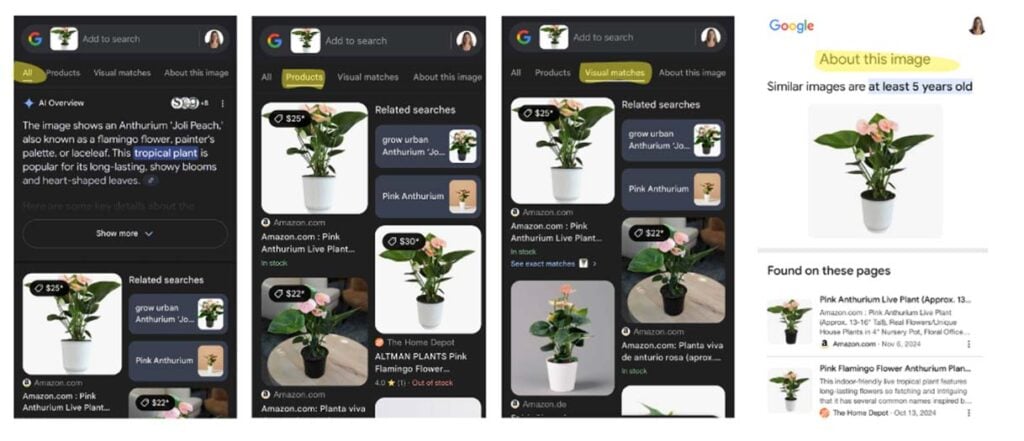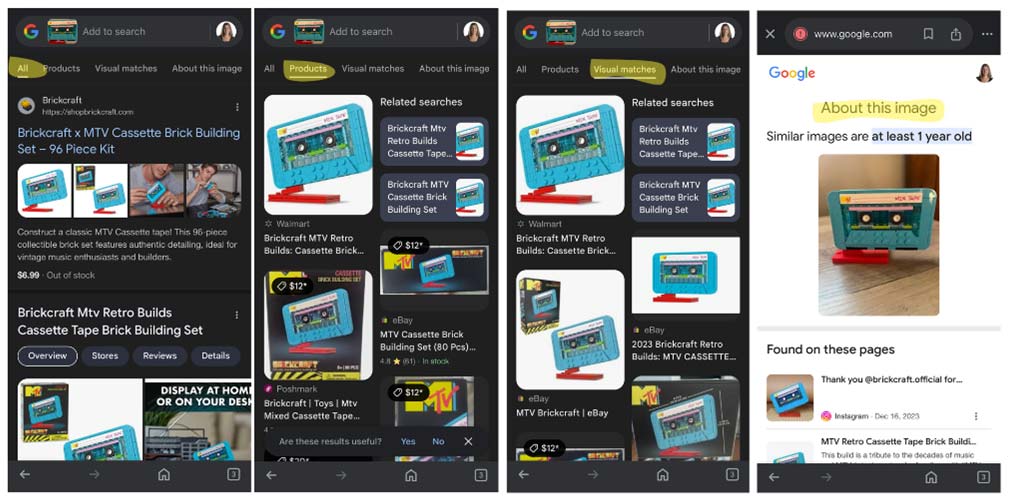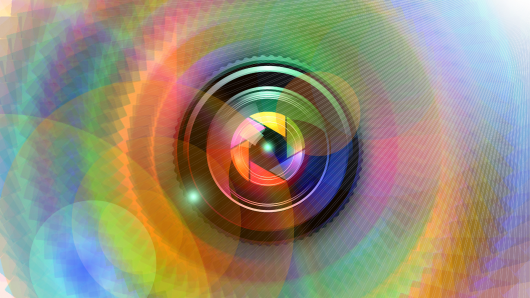Visual search just got a lot more shoppable. Google has expanded its Shopping ad capabilities into Google Lens, enabling advertisers to reach users at the moment of visual discovery. This exciting integration opens new doors for ecommerce brands to showcase products to high-intent shoppers, right when curiosity strikes.
What is Google Lens?
Google Lens is an AI-powered visual search tool that lets users take a photo or upload an image to discover what it is, where to buy it, and who sells it. It’s built into Android phones, the Google app, Chrome, and even Google Images on desktop. Users turn to Google Lens for everything from translating signs and scanning QR codes to identifying plants and – now more than ever – shopping for products they discover visually.
Shopping Ads in Google Lens Results
Google Lens supports both desktop and mobile experiences, helping users discover and shop for products across Google surfaces, like Lens, Search, Images, YouTube, and Discover.
On desktop, users can upload an image, like the Kate Spade handbag shown below, and receive instant results including shopping matches, prices, and retailers like Poshmark and eBay.
These desktop screenshots illustrate how Lens recognizes products and delivers shopping-focused results.

When someone searches using Google Lens – like scanning a sneaker, houseplant, or toy – Google analyzes the image and shows results such as:
- Product listings from across the web
- Sponsored Shopping Ads from advertisers
- Prices and retailers
- Ratings and availability
This means brands using Google Ads can now have their products shown directly within Google Lens visual search results, giving advertisers a new way to capture interest with stunning imagery and smart targeting.
Google Lens in Action on Mobile
On mobile, Google Lens makes visual discovery fast and intuitive. In this example, I uploaded a photo of a Pink Anthurium plant. Lens instantly identified it as Anthurium ‘Joli Peach’ and returned:
- Shopping listings from Amazon and Home Depot
- Visually similar product results
- Metadata such as image age and source pages
Below are Google Lens results displayed across multiple tabs, demonstrating how Lens not only finds product listings but also pulls visual matches and contextual info from around the web.

Another Mobile Example: Cassette Toy
In another example, I used Google Lens to snap a photo of a retro cassette toy. Lens returned:
- Shopping Ads from retailers like Walmart, eBay, and Poshmark
- Visual matches from other listings and product variations

Like the plant example above, these Google Lens results show the cassette toy identified and categorized across the “All,” “Products,” “Visual matches,” and “About this image” tabs – illustrating how Lens supports both lifestyle and niche product discovery.
4 Steps To Get Your Products To Appear in Google Lens
If you’re running Google Shopping or Performance Max campaigns, your products may already be eligible to appear in Google Lens results. Eligibility generally depends on having an active product feed in Google Merchant Center Next, proper campaign setup, and compliance with Google’s advertising policies. To improve your chances of showing up in Google Lens results, follow these steps:
- Upload high-quality product images. Use clear, uncluttered, and visually appealing images. Google recommends high-resolution photography with simple backgrounds to help the visual matching engine identify products more effectively.
- Use structured product data. Ensure your product feed in Merchant Center includes accurate and complete information, such as titles, GTINs (Global Trade Item Numbers), prices, availability, and other relevant attributes.
- Enable Free Listings. In Google Merchant Center Next, go to the gear icon → Data Sources → and opt into Free Listings to ensure your products are eligible to appear across unpaid Google surfaces, including Lens.
- Leverage Performance Max campaigns. These campaign types use Google’s AI to automatically serve your products across all eligible properties, including Google Lens, YouTube, Discover, Search, and Gmail.
Can You Track Performance from Google Lens?
Once your products are eligible, how can you tell if Google Lens is actually delivering results?
Right now, Google Ads doesn’t report on Google Lens separately, so impressions and clicks from Lens are grouped into your broader Performance Max data. That means you won’t see a “Lens” line item, but you can still look for patterns:
- Performance Max Trends
Since Lens placements run through PMax, monitor asset groups with strong visuals. If those products suddenly see higher click-through or conversion rates, Lens may be contributing. - Visual Content Impact
If you’ve updated product images – like switching to high-resolution, clutter-free shots – and those items start performing better, it could be due to improved visibility in visual search placements like Lens.
While there’s no direct Lens reporting (yet), focusing on visual assets and monitoring PMax performance are the best ways to spot Lens-driven impact.
Why Google Lens Matters
High-intent moments are gold in ecommerce, and Google Lens captures those moments in a uniquely visual way. It enables shoppers to act instantly on what they see, turning real-world or digital images into shoppable opportunities.
Key Benefits Include:
- Reach shoppers beyond traditional keyword-based search
- Match user intent through images, not just text
- Appear across Google’s full network, including Lens, Search, YouTube, Discover, and Gmail
Google Lens is transforming how people shop, turning curiosity into commerce. Whether someone snaps a photo of a purse or a plant, the experience is immediate, visual, and actionable.
For marketers, it’s all about showing up at the exact moment inspiration strikes.
Are your products ready for visual discovery? Now’s the time to make sure they are, because today, the camera is the new search bar.








